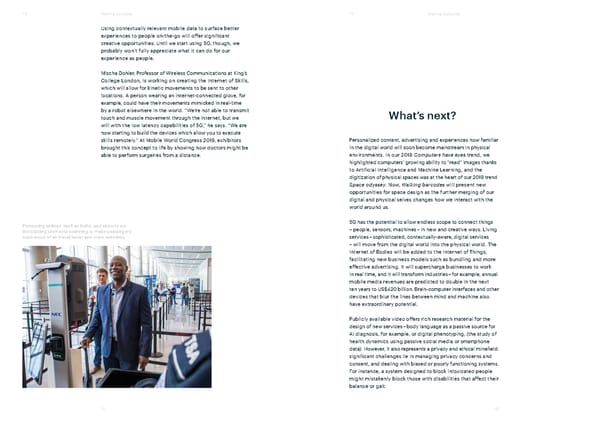T3 Walking barcodes T3 Walking barcodes Using contextually relevant mobile data to surface better experiences to people on-the-go will offer significant creative opportunities. Until we start using 5G, though, we probably won’t fully appreciate what it can do for our experience as people. Mischa Dohler, Professor of Wireless Communications at King’s College London, is working on creating the Internet of Skills, which will allow for kinetic movements to be sent to other locations. A person wearing an internet-connected glove, for example, could have their movements mimicked in real-time by a robot elsewhere in the world. “We’re not able to transmit What’s next? touch and muscle movement through the internet, but we will with the low latency capabilities of 5G,” he says. “We are now starting to build the devices which allow you to execute skills remotely.” At Mobile World Congress 2019, exhibitors Personalized content, advertising and experiences now familiar brought this concept to life by showing how doctors might be in the digital world will soon become mainstream in physical able to perform surgeries from a distance. environments. In our 2018 Computers have eyes trend, we highlighted computers’ growing ability to “read” images thanks to Artificial Intelligence and Machine Learning, and the digitization of physical spaces was at the heart of our 2019 trend Space odyssey. Now, Walking barcodes will present new opportunities for space design as the further merging of our digital and physical selves changes how we interact with the world around us. Pioneering airlines, such as Delta, and airports are 5G has the potential to allow endless scope to connect things introducing biometric scanning to make passengers’ – people, sensors, machines – in new and creative ways. Living experience of air travel faster and more seamless. services – sophisticated, contextually-aware, digital services – will move from the digital world into the physical world. The Internet of Bodies will be added to the Internet of Things, facilitating new business models such as bundling and more effective advertising. It will supercharge businesses to work in real time, and it will transform industries – for example, annual mobile media revenues are predicted to double in the next ten years to US$420 billion. Brain-computer interfaces and other devices that blur the lines between mind and machine also have extraordinary potential. Publicly available video offers rich research material for the design of new services – body language as a passive source for AI diagnosis, for example, or digital phenotyping, (the study of health dynamics using passive social media or smartphone data). However, it also represents a privacy and ethical minefield: significant challenges lie in managing privacy concerns and consent, and dealing with biased or poorly functioning systems. For instance, a system designed to block intoxicated people might mistakenly block those with disabilities that affect their balance or gait. 41 42
 Accenture-Fjord-Trends-2020-Report Page 18 Page 20
Accenture-Fjord-Trends-2020-Report Page 18 Page 20